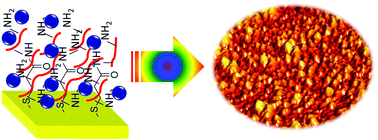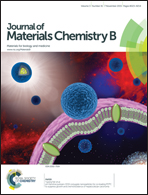Surface self-assembled hybrid nanocomposites with electroactive nanoparticles and enzymes confined in a polymer matrix for controlled electrocatalysis†
Abstract
A three-dimensional network of highly branched poly(ethyleneimine) (PEI) is designed and synthesized on gold electrode surfaces. A self-assembled monolayer (SAM) of dithiobis(succinimidyl propionate) (DTSP) on a gold electrode was first prepared, which is confirmed by the reductive desorption of Au–S units. The PEI polymer was then covalently immobilized onto the DTSP layer, leaving free primary amine groups acting as a 3D skeleton for high loading of electroactive enzyme-size Prussian blue nanoparticles (PBNPs, 6 nm) via electrostatic trapping. Atomic force microscopy was used to disclose the microscopic structures of the different layers during the surface architecture formation. The resulting surface-bound nanostructured composite shows high electrochemical activity arising from confined PBNPs, and acts as an efficient electrocatalyst towards H2O2 reduction. Facile electron communication is achieved as reflected by a large electron transfer (ET) rate constant (ks) of 200 s−1, and the possible electron propagation mechanisms in the polymer network are discussed. This surface/interfacial nanocomposite can be further used in the accommodation of enzymes for electrochemical bio-catalysis. Glucose oxidase (GOD) was used towards this end, in a proof-of-concept study. This enzyme can be co-trapped in the PEI matrix and is interconnected with PBNPs, leading to highly efficient electrocatalyic oxidation and detection of glucose.


 Please wait while we load your content...
Please wait while we load your content...